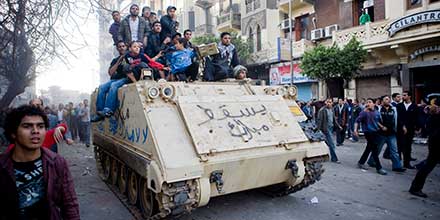
This article was originally published by Political Violence @ a Glance on 8 May 2018.
What drives governments to crack down on and kill their own civilians in the context of popular uprisings? This is the topic of our newly-released special report with the International Center on Nonviolent Conflict. In it, we explore why governments engage in mass killings – or the intentional killing of 1,000 or more civilian noncombatants – in the context of both violent and nonviolent mass uprisings. Among 308 popular uprisings since 1955, we find that mass killings are surprisingly common, yet they are strongly associated with certain types of resistance. More broadly (and strikingly), we find that characteristics of the uprisings are just as significant as features of the states they are confronting.
Specifically, armed uprisings are nearly three times as likely to elicit state violence: nearly 68% of violent uprisings (92 of 135) encounter mass killings while about 23% (40 of 173) of predominantly nonviolent movements do. We think this is because nonviolent resistance generally poses a lower threat of personal harm, lowering the likelihood that state security forces – those receiving orders to engage in mass killings – unquestioningly obey commands to employ widespread lethal force. Indeed, leaders who order their armed forces to crack down on unarmed civilians run the risk of defection and insubordination. In numerous cases, from Serbia to Egypt to Tunisia, critical turning points occurred when the military sided with civilians and ignored their orders to repress unarmed protesters. The possibility of losing the loyalty of security forces might ultimately deter leaders from launching mass atrocities in the first place. On the other hand, violent campaigns threaten the safety of incumbent leaders and security forces alike. This might inspire them to hold on to power at any cost, even ordering or carrying out a mass atrocity in an attempt to survive.
Moreover, we find that the likelihood of mass killings increases when foreign states provide material aid to dissidents. Violent insurgencies often rely on such assistance to generate money and accumulate weapons that are necessary to confront the regime. Nonviolent movements, however, often partner with non-governmental organizations that instead provide less overt forms of support. This might include knowledge-sharing and capacity-building efforts that yield more effective grassroots mobilization and repression management. When states provide sanctuary, money, or weapons to dissidents, as often happened during the Cold War, incumbent leaders and their security forces are more likely to view dissidents and their suspected civilian supporters as increasingly threatening foreign agents. Perceiving an uprising as an existential threat to the sovereignty of the country ultimately makes it likelier that security forces obey orders to engage in mass killings.
Similarly, we find that the likelihood of mass killings is greater when foreign states provide material aid to the governments the movements oppose. Iran and Russia providing assistant to the Assad government in Syria, for instance, certainly provided material and diplomatic cover for Assad’s regime to escalate levels of violence against Syrian dissidents.
Our research has important implications for activists seeking to challenge a regime while reducing the likelihood of mass atrocities. First, although it is the case that people involved in nonviolent uprisings often face beatings, arrests, and other forms of coercion (including isolated incidents of lethal violence), violent uprisings are linked to a much greater risk of large-scale civilian victimization. As such, sufficient planning, training, and preparation to maintain nonviolent discipline is key—especially (and paradoxically) when confronting brutal regimes.
Second, choices about whether or not to actively seek direct international aid are also important. Foreign material assistance to an uprising, whether violent or nonviolent, can work to dissidents’ disadvantage. By collaborating with foreign states, the movement might appear increasingly threatening to regime elites and their security forces. Although we cannot say for sure, other forms of external assistance may prove more useful. In Argentina and East Timor, for instance, foreign states supported the opposition not by sending money or arms, but by bringing attention to atrocities committed by the regime.
Moreover, dissidents should view with caution any attempts from foreign states to provide them with direct support (e.g. material or financial assistance) and should instead seek outside assistance on a selective basis where it helps to address specific needs or weaknesses (e.g. its capacity to manage repression or to enhance its tactical innovation).
Finally, campaigns and individual dissidents can collect information that might be useful for preventing mass atrocities in the future. There is a need for activists as well as domestic and international actors on the ground to meticulously record and collect relevant information including evidence of when, how, and in what way nonviolent mobilization and self-organization might have protected communities and reduced their exposure to mass violence. These data, in turn, would help both future dissidents and external actors to develop more effective policy instruments to prevent mass atrocities.
Note: This text was adapted from our special report “Nonviolent Resistance and Prevention of Mass Killings During Popular Uprisings.” Download the report here.
About the Authors
Dr. Evan Perkoski is an assistant professor in the Department of Political Science at the University of Connecticut.
Dr. Erica Chenoweth is a Professor at the Josef Korbel School of International Studies at the University of Denver.
For more information on issues and events that shape our world, please visit the CSS website.

